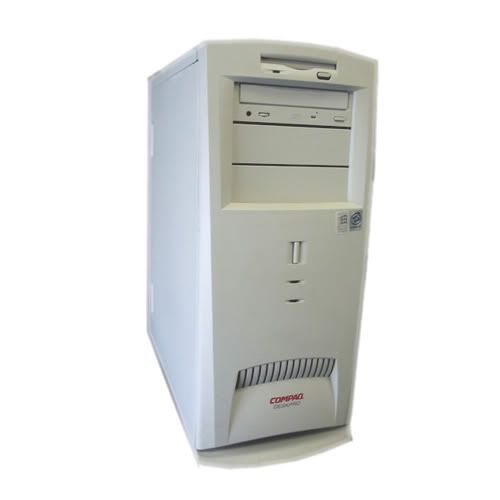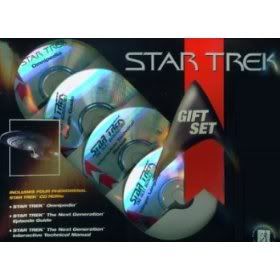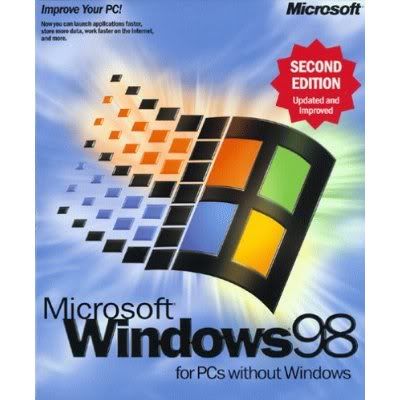Computer History
Every once in a while, I get a little nostalgic for the glory days of computing (although, depending on who you ask, that could be a very different date range). For me, it's 1992-1999. Those seven years were my first steps into computing, the Internet, gaming, etc. So, for this entry, I thought I would recall as much as I could about technology at that time. You're not obligated to read this; I'm merely writing this for my own amusement.
I don't remember the first computer I ever interacted with. It was most likely one of the Macintosh SEs that Franklin Local was so fond of in the late 1980s/early 1990s. Or possibly an Apple ][e. Either way, I knew I had to have one. It was 1992, so there wasn't really any other place to go than SUN TV. Who remembers them? Apple computers were prohibitively expensive at the time (around $5,000), and my parents weren't willing to let a nine year-old novice bang away on something that cost almost as much as a new car. I was heartbroken, because all I had used was Apple computers, so I did not know who else to turn to.
Then, a few weeks later, I noticed one computer in the Roseville Middle School library that stuck out like a sore thumb. It did not run the software with the funny little smiling face (Macintosh System 7) that the Performas in the library ran. No, it ran an operating system that I had never heard of before: Windows 3.1. I asked the librarian what kind of computer it was. She told me it was a Compaq. I forget the model...this was almost seventeen years ago. Anyway, my mom and I went back to Sun, and we found a Compaq DeskPro. It had an Intel 80386 processor, clocked at (I think) 50 MHz. It ran Windows 3.1 from an 800 megabyte hard drive. By today's standards, it was slow as shit, but it worked well for me. Minesweeper, Solitaire, Microsoft Word and primitive telecommunications abilities suited me just fine. I first discovered the joys of BBSes with the built-in 14.4kbps modem. Although I soon learned the concept of area codes when I dialed a BBS in another state and we had an almost $100 phone bill. No more calling outside of 614 after that.

I started to feel pretty bold after a couple years. I learned from computer-related BBSes how to modify system files, and I soon started making my own custom color schemes and startup pictures. One fateful day, though, I messed up a boot file and the Compaq never booted again. They had not included (or Sun TV removed from the box) the Windows 3.1 install diskettes, so I had no recourse. By then, though, it was 1996, and the world of Windows 95 was waiting for me to explore. We called Gateway (then called "Gateway 2000") and after a couple weeks, a cow-spotted box arrived in the mail, containing a VHS tape with some product demos and information. We called them back, but their prices were just far too high for the specs. Same with Dell. We soon figured out we needed to go to a brick-and-mortar store and look at the computers in person.
So, my parents and I packed into the Taurus and headed up to fancy-schmancy Columbus and CompUSA. It looked like a huge warehouse full of technology--primitive big-screen TVs (remember how ridiculous those looked in 1996?), VCRs, and of course, computers. I scanned the aisles, tried a few systems, and then...I found it. Its purple and grey chassis immediately separated it from the rest of the beige boxes. It was the Sony PCV-100. It was attractive and striking, and for the time, powerful. And expensive. $4,500. But, my mom bought it for me. Here it is in all of its purple glory:

Sony had recently entered the console gaming market with the PlayStation, and with the PCV series of computers, they wanted to enter the computer gaming market as well. The PCV-100 was loaded to the gills for 1996. Intel Pentium with MMX Technology running at 100 MHz. 4,300 megabyte hard disk drive (about 4 gigs, at least 25% bigger than most consumer hard drives at the time). 24 megs of the fastest RAM on the market. 15" Sony Trinitron monitor with built-in speakers and subwoofer. It even had two USB ports, even though there was literally nothing on the consumer market at the time that could take advantage of them. It ran Windows 95 OEM version 2.1, which included Microsoft Plus! and primitive USB support. It came packed with a lot of programs, including the full Microsoft Office 95, MechWarrior 2, Grolier's Encyclopedia '96, the Billboard Music Guide and a lot of others that I'm forgetting. Oh, how I wish I had my hands on that little CD wallet again. Those programs were classic. Luckily, I still have some of the CDs.
It also ran this shell called "VAIOSpace" that ran overtop of Windows 95. It was a shell of a shell, since Windows 95 ran on top of MSDOS. You can see VAIOSpace in that picture above. It was pretty cool. It offered a fake-3D (2.5D) view of the inside of a cube. Each face had different things you could do (games, productivity, Internet, etc.). It was pretty cool, especially to my 12 year-old self. I recently found the recovery disc for the PCV-100. I tried to "recover" the system to a new blank Windows 95 installation in Parallels for Mac, but the disc is just smart enough to know whether or not it is running on a Sony computer. It saddened me that I could not experience VAIOSpace again. Oh well.
CompUSA was also running a few deals. If you spent more than $500 in the store, you got a free Samsung VCR. That VCR lasted me through college. It would still be here today if my father had not stepped on it and broke it. Anyway, if you spent more than $2,000 on a new computer, you got to choose as much software or accessories as you wanted, as long as the total was less than 10% of the machine's price. So, I got carte blanche to get about $400 worth of software and accessories. I ended up getting the Star Trek CD-ROM Gift Set (which I still have, thank you very much), Microsoft Streets and Maps, some miscellaneous games and a fake leather CD wallet. Not too shabby.

I had a lot of good times with that computer. In 1998, I bought a CD burner at Walmart (on sale for a paltry $176), and was horrified to learn that Windows 95 just simply could not understand how to talk to it. Walmart refused to take it back, so I shelved it until I could get a new computer. Later that year, my mom bought me a Lexmark all-in-one printer/scanner/copier. It too refused to fall in line with Windows 95. Worse still, it was USB, and Windows 95's USB support was crappy at best. But, I loved my computer, and did not want to get another one. What to do? There was only one thing to do. Upgrade to Windows 98. We bought it at CompUSA for $99.95. It worked, but not that well. It did let me use my printer and CD burner. In 1999, they released Windows 98 Second Edition. CompUSA ran a deal that would allow you to buy the Second Edition for 40% if you provided a receipt showing you had bought the original Windows 98. Thank goodness I kept it! Windows 98 Second Edition served me well for almost four years until I bought the Dell in late 2002. I still think that Windows 98SE might be the best operating system Microsoft ever put out.

I've been emulating a lot of these old OSes and programs with Parallels on the Mac. It's so fun to install them and boot into them for the first time. It almost feels like I'm 12 years old again. So far, I've got DOS 6.22, Windows 95, Windows NT 4.0, Windows 98SE, and Windows XP Professional SP2. I mostly use 98SE to run my old games/programs, and XP Pro for actual Windows work.
I just ordered a sealed copy of Windows 3.1 from a guy on eBay for $1.00! I'm going to use a USB floppy drive to install it on Parallels. I bought the floppy drive because I recently came across an old box of floppies from my middle school and high school days. They have all my old reports, novel papers, etc. It will be exciting when I get to read them again.
I don't remember the first computer I ever interacted with. It was most likely one of the Macintosh SEs that Franklin Local was so fond of in the late 1980s/early 1990s. Or possibly an Apple ][e. Either way, I knew I had to have one. It was 1992, so there wasn't really any other place to go than SUN TV. Who remembers them? Apple computers were prohibitively expensive at the time (around $5,000), and my parents weren't willing to let a nine year-old novice bang away on something that cost almost as much as a new car. I was heartbroken, because all I had used was Apple computers, so I did not know who else to turn to.
Then, a few weeks later, I noticed one computer in the Roseville Middle School library that stuck out like a sore thumb. It did not run the software with the funny little smiling face (Macintosh System 7) that the Performas in the library ran. No, it ran an operating system that I had never heard of before: Windows 3.1. I asked the librarian what kind of computer it was. She told me it was a Compaq. I forget the model...this was almost seventeen years ago. Anyway, my mom and I went back to Sun, and we found a Compaq DeskPro. It had an Intel 80386 processor, clocked at (I think) 50 MHz. It ran Windows 3.1 from an 800 megabyte hard drive. By today's standards, it was slow as shit, but it worked well for me. Minesweeper, Solitaire, Microsoft Word and primitive telecommunications abilities suited me just fine. I first discovered the joys of BBSes with the built-in 14.4kbps modem. Although I soon learned the concept of area codes when I dialed a BBS in another state and we had an almost $100 phone bill. No more calling outside of 614 after that.

I started to feel pretty bold after a couple years. I learned from computer-related BBSes how to modify system files, and I soon started making my own custom color schemes and startup pictures. One fateful day, though, I messed up a boot file and the Compaq never booted again. They had not included (or Sun TV removed from the box) the Windows 3.1 install diskettes, so I had no recourse. By then, though, it was 1996, and the world of Windows 95 was waiting for me to explore. We called Gateway (then called "Gateway 2000") and after a couple weeks, a cow-spotted box arrived in the mail, containing a VHS tape with some product demos and information. We called them back, but their prices were just far too high for the specs. Same with Dell. We soon figured out we needed to go to a brick-and-mortar store and look at the computers in person.
So, my parents and I packed into the Taurus and headed up to fancy-schmancy Columbus and CompUSA. It looked like a huge warehouse full of technology--primitive big-screen TVs (remember how ridiculous those looked in 1996?), VCRs, and of course, computers. I scanned the aisles, tried a few systems, and then...I found it. Its purple and grey chassis immediately separated it from the rest of the beige boxes. It was the Sony PCV-100. It was attractive and striking, and for the time, powerful. And expensive. $4,500. But, my mom bought it for me. Here it is in all of its purple glory:

Sony had recently entered the console gaming market with the PlayStation, and with the PCV series of computers, they wanted to enter the computer gaming market as well. The PCV-100 was loaded to the gills for 1996. Intel Pentium with MMX Technology running at 100 MHz. 4,300 megabyte hard disk drive (about 4 gigs, at least 25% bigger than most consumer hard drives at the time). 24 megs of the fastest RAM on the market. 15" Sony Trinitron monitor with built-in speakers and subwoofer. It even had two USB ports, even though there was literally nothing on the consumer market at the time that could take advantage of them. It ran Windows 95 OEM version 2.1, which included Microsoft Plus! and primitive USB support. It came packed with a lot of programs, including the full Microsoft Office 95, MechWarrior 2, Grolier's Encyclopedia '96, the Billboard Music Guide and a lot of others that I'm forgetting. Oh, how I wish I had my hands on that little CD wallet again. Those programs were classic. Luckily, I still have some of the CDs.
It also ran this shell called "VAIOSpace" that ran overtop of Windows 95. It was a shell of a shell, since Windows 95 ran on top of MSDOS. You can see VAIOSpace in that picture above. It was pretty cool. It offered a fake-3D (2.5D) view of the inside of a cube. Each face had different things you could do (games, productivity, Internet, etc.). It was pretty cool, especially to my 12 year-old self. I recently found the recovery disc for the PCV-100. I tried to "recover" the system to a new blank Windows 95 installation in Parallels for Mac, but the disc is just smart enough to know whether or not it is running on a Sony computer. It saddened me that I could not experience VAIOSpace again. Oh well.
CompUSA was also running a few deals. If you spent more than $500 in the store, you got a free Samsung VCR. That VCR lasted me through college. It would still be here today if my father had not stepped on it and broke it. Anyway, if you spent more than $2,000 on a new computer, you got to choose as much software or accessories as you wanted, as long as the total was less than 10% of the machine's price. So, I got carte blanche to get about $400 worth of software and accessories. I ended up getting the Star Trek CD-ROM Gift Set (which I still have, thank you very much), Microsoft Streets and Maps, some miscellaneous games and a fake leather CD wallet. Not too shabby.

I had a lot of good times with that computer. In 1998, I bought a CD burner at Walmart (on sale for a paltry $176), and was horrified to learn that Windows 95 just simply could not understand how to talk to it. Walmart refused to take it back, so I shelved it until I could get a new computer. Later that year, my mom bought me a Lexmark all-in-one printer/scanner/copier. It too refused to fall in line with Windows 95. Worse still, it was USB, and Windows 95's USB support was crappy at best. But, I loved my computer, and did not want to get another one. What to do? There was only one thing to do. Upgrade to Windows 98. We bought it at CompUSA for $99.95. It worked, but not that well. It did let me use my printer and CD burner. In 1999, they released Windows 98 Second Edition. CompUSA ran a deal that would allow you to buy the Second Edition for 40% if you provided a receipt showing you had bought the original Windows 98. Thank goodness I kept it! Windows 98 Second Edition served me well for almost four years until I bought the Dell in late 2002. I still think that Windows 98SE might be the best operating system Microsoft ever put out.

I've been emulating a lot of these old OSes and programs with Parallels on the Mac. It's so fun to install them and boot into them for the first time. It almost feels like I'm 12 years old again. So far, I've got DOS 6.22, Windows 95, Windows NT 4.0, Windows 98SE, and Windows XP Professional SP2. I mostly use 98SE to run my old games/programs, and XP Pro for actual Windows work.
I just ordered a sealed copy of Windows 3.1 from a guy on eBay for $1.00! I'm going to use a USB floppy drive to install it on Parallels. I bought the floppy drive because I recently came across an old box of floppies from my middle school and high school days. They have all my old reports, novel papers, etc. It will be exciting when I get to read them again.